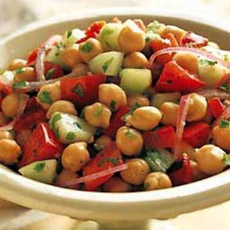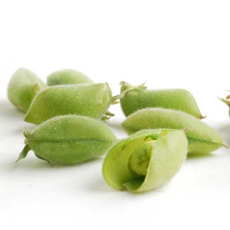RECIPE: Chickpea Salad
|
You can round out the Moroccan Chicken recipe we just published with a green salad, and you can also add another cold salad. We’re not sure how this Chickpea Salad recipe came to us. Easy and tasty, it’s from Meaghann McGoun of Love With Food. Thanks, Meghann. We especially like this as a spring and summer side with anything Mediterranean-inspired, including simple grilled proteins. Chickpeas themselves, which are seeds of the plant, are also high in protein. The recipe can be made a day in advance. Prep time is 30 minutes. You can add more veggies to the salad: carrot and, celery, for starters. 1. DRAIN and rinse the chickpeas. 2. CHOP the tomatoes, cucumber, onion and pepper to bite-sized pieces. Finely chop the jalapeño and cilantro. Combine the chickpeas and vegetables in a large bowl. 3. WHISK together the oil, vinegar, sugar, salt, pepper and and cilantro. Add to the bowl and mix until the salad is coated. Cover and refrigerate for at least one hour for the flavors to blend. The Oxford English Dictionary lists a 1548 print reference to chickpeas (“Cicer may be named in English Cich, or ciche pease, after the Frenche tongue.” But the bean has been eaten since long before recorded history. |

|
|
|
Chickpeas were among the first crops cultivated by man, known as the eight founder crops of the Fertile Crescent. It is one of the earliest cultivated legumes: 7,500-year-old remains have been found in the Middle East. (Cicer arietinum) is a legume of the family Fabaceae family, known variously as the legume, pea, or bean family. You may have seen some of its other names: ceci or cece (Italian), chana or Kabuli chana (Northern India), Egyptian pea, garbanzo or garbanzo bean (Spanish), gram or Bengal gram (British India). The word chickpea in English came from the French chich, found in print in English in 1388. “Chick-pea” is found in print in the mid-18th century. The name evolved from traces through the French chiche to cicer, Latin for chickpea. Fun fact: The Roman cognomen Cicero came from cicer. Yes, the great orator Roman Marcus Tullius Cicero—also a consul, constitutionalist, lawyer, philosopher, political theorist and politician—was a member of the Chickpea family. More seriously, a cognomen was the third name of a citizen of ancient Rome—the hereditary name that we call a surname, which passed from father to children. The second name—the family name or clan name—identified a particular branch within a family, or family within a clan. Peas and beans are both legumes and seeds, both members of the Fabaceae botanical family. Chickpea, also called garbanzo bean, is actually a bean. Some key differences:
|
||




